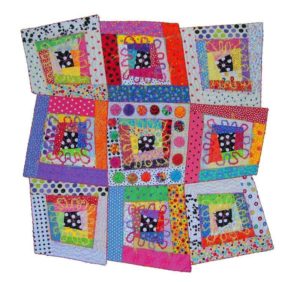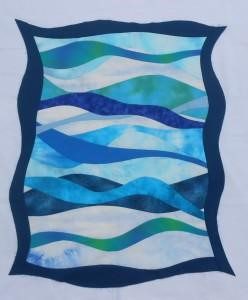Amy Stewart Winsor
Amy Stewart Winsor is a quilt artist, instructor, and author from Apex, North Carolina who doesn’t measure, doesn’t make templates, avoids matching corners, never plans ahead, and usually fudges the rules. Her workshops are especially directed toward Precision-Impaired Quilters like herself.
Her first book, Frazzled Fancies Quilts, and first pattern, Good Neighbors, were published December 2014, and are now available on her Etsy shop.
She teaches nationally, and enthusiastically encourages her students to find the techniques they enjoy most, and to spend their quilting time frolicking in the fabric instead of stressing out.
Lecture: Fixing Mistakes Creatively
(Saturday Afternoon)
Some people say there are no such things as mistakes, they are just “design opportunities”. In this lecture Amy will show examples of quilts which were going wrong, and how they were rescued.
Some of the techniques which will be covered:
- Covering up mistakes with applique
- Cutting off mistakes and adding new additions
- Using left over blocks in a new quilt
- Splitting an ugly top and adding strips
- Embellishing to distract from mistakes
- Using tulle (bridal veil netting) to change colors or cover seams
- And many, many more!
Class: Crooked Log Cabin for the Precision-Impaired – (cancelled)
(6 hours – Friday)
 This is a free-spirited technique for those who love playing with color better than they like planning every detail. You will sew like crazy and create most of a wall-hanging quilt top.
This is a free-spirited technique for those who love playing with color better than they like planning every detail. You will sew like crazy and create most of a wall-hanging quilt top.
After making your blocks by machine in class, don’t square them up. You will learn how to fit “non-square” blocks together, and pillowcase the edge with notches, creating Amy’s original “Crooked Borders”.
Supply List
- Sewing machine
- Basic sewing supplies, thread rotary cutter, rotary cutting mat (larger is better)
- 12″ or longer quilting ruler
- Fabric: Cotton quilting fabric (see instructions below)
Instructions for Choosing Quilt Fabrics
Each of your blocks will consist of a center, an inner square, and an outer square. For a small wall-hanging, you will make 9 blocks (4 in one value, 5 in the other). The total yardage used for the quilt top is about 2 ½ yards.
Required: One fabric to use in all your centers: One fat quarter will be plenty for 9 blocks. Choose a color that stands out as different, shows up well and contrasts greatly with all your other fabrics. If you use red for your center, don’t use red elsewhere in the quilt. Don’t use white.
If you already have a fabric stash, bring all your fabrics in the color scheme you would like to use. If using scraps, using 20-30 different fabrics is typical.
Example #1: Black and white dots for centers, red for dark outer squares, pink for light inner squares, deep purple for dark inner squares, lavender for light outer squares.
Example #2: Bright orange for centers. Dark animal prints for dark outer borders, light tans for light inner borders, and the opposite for the other half of the blocks.
If desired, before class: From each fabric, cut one 2″ wide strip, and one 3″ wide strip, up to 30″ long. (This will save you time in class, but some may go unused.)
(Please don’t cut more than these 2 strips from each fabric.)
Class: Curvaceous Rivers and Skies – (cancelled)
(3 hours – Saturday morning)
 Learn to create beautiful backgrounds representing rivers or skies, sewn with curved piecing using no rulers or patterns. Each unique river or sky will be cut freehand with gentle curves using a rotary cutter. Learn to judge where to add your next color, using solids or tone-on-tone fabrics. Also, learn to make leaf shapes and kayak shapes from curved piecing, add curvy borders around the center panel, and apply bias binding to a curved edge.
Learn to create beautiful backgrounds representing rivers or skies, sewn with curved piecing using no rulers or patterns. Each unique river or sky will be cut freehand with gentle curves using a rotary cutter. Learn to judge where to add your next color, using solids or tone-on-tone fabrics. Also, learn to make leaf shapes and kayak shapes from curved piecing, add curvy borders around the center panel, and apply bias binding to a curved edge.
These quilts might appear to be appliqued, but are completely sewn using curved piecing.
The River or Sky quilt panel will be approximately 26″x 34″ including border, 20″ x 30″ without border.
Supply List
Sewing machine required (needs only straight stitch).
Bring a minimum of 9 different fabrics. Each piece of fabric must be at least 20” wide. If you bring fat quarters, you will use strips off each one, and be able to trade some of your leftovers to other students.
Please bring only good-quality quilting cottons. Other types fray too much. Batiks, hand-dyes, solid colors, or tiny prints that appear to be solid are the best choices. Prints or extremely blotchy batiks are not recommended.
